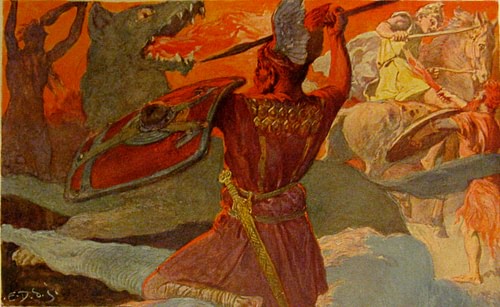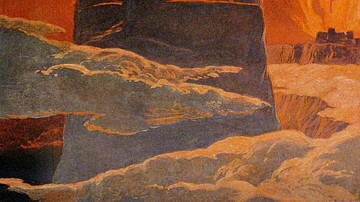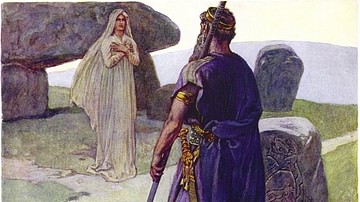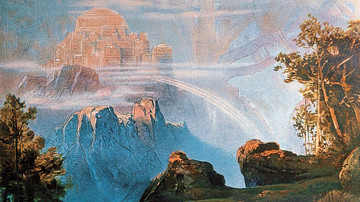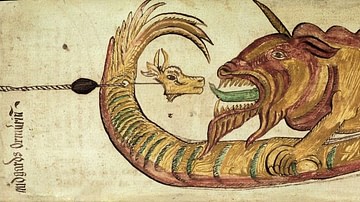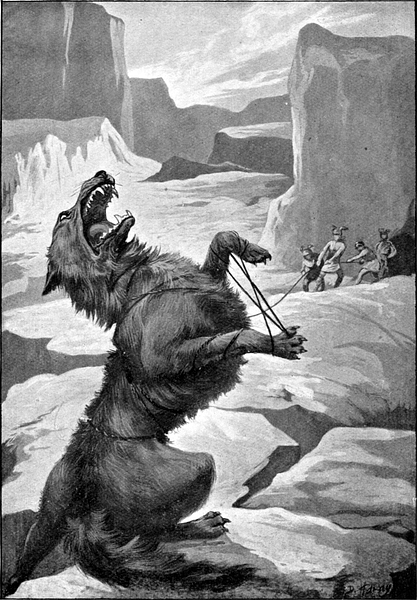
Fenrir is the great wolf in Norse Mythology who breaks free from his chains at Ragnarök, the twilight of the gods, kills Odin, and is then killed by Odin’s son Vidarr. Fenrir is the son of the trickster god Loki and brother of the World Serpent Jormungandr and the jotunn Hel.
He is also known as the Fenris Wolf (also given as Fenris-wolf) and Vanargand (“monster of van”) usually understood to mean “creature of expectation” because he was prophesied to participate in the destruction of the gods. His name is pronounced Fen-rear, and he was born of the union of Loki and the giantess Angrboda. A prophecy foretold that the children of Loki would cause the gods of Asgard trouble and so they were taken from Jotunheim, land of the giants where they lived with their mother, and brought to Asgard. Odin then hurled Jormungandr into the sea, dropped Hel into the depths of the realm of Niflheim, and, eventually, had Fenrir chained to a rock. All three children would avenge themselves at Ragnarök.
The story of Fenrir, like all of Norse Mythology, survives today through a Christianized lens and it is difficult to tell what aspects of the tales were original Norse beliefs and what are later interpretations. There are a number of wolves mentioned in Norse Mythology (notably Fenrir’s sons Hati and Skoll) but it is thought that most, if not all, were originally Fenrir as some tales attribute to him certain actions later given to Hati and Skoll.
Although Fenrir is understood as an antagonist of the gods and one of the “villains” of the story of Ragnarök, the original story makes clear that Odin’s and the other gods’ treatment of the great wolf contributed to his siding with the forces of chaos against them.
The World of the Myth
Before the beginning of time, there was only the World Tree Yggdrasil and the misty void of Ginnungagap bordered on one side by the fiery realm of Muspelheim and on the other by the ice world of Niflheim. The fires of Muspelheim eventually began melting the ice of Niflheim and the giant Ymir emerged along with Audhumla the cow. Audhumla licked the ice for sustenance and revealed Buri who then mated with the giantess Bestla. Bestla gave birth to Odin, Vili, and Ve, the first of the gods, while Ymir, through self-fertilization, birthed the giants.

Odin, Vili, and Ve attacked and killed Ymir whose gushing blood drowned all the other giants except for Bergelmir and his wife who fled on a raft and would generate more giants who would swear eternal enmity with the gods of Asgard. From Ymir’s body, Odin and his brothers created the world of the Nine Realms:
- Asgard – Realm of the Aesir, joined to Midgard by the rainbow bridge Bifrost
- Alfheim – Realm of the Elves
- Hel – Realm of those who died of illness or old age and then of most people
- Jotunheim – Realm of the Giants and Frost Giants
- Midgard – Realm of the Humans between Asgard and Jotunheim
- Muspelheim – Realm of Fire, the fire-giant Surtr, and Surtr's forces of chaos
- Nidavellir/Svartalfheim – Realm of the Dwarves beneath the earth
- Niflheim – Realm of Ice, Snow, and Mist near Muspelheim
- Vanaheim – Realm of the Vanir
They then created the first man (Ask) and woman (Embla) from an Ash and Elm tree, respectively, and ringed the realm of Midgard with a high wall to protect the helpless creatures from the giants. After humans were created, the gods made animals and then Bifrost, the rainbow bridge, which joined Midgard to Asgard. The Nine Realms would exist until the day of Ragnarök when all would be destroyed in a great battle between the gods – the forces of order – and those of chaos which included the god Loki and his children.
Fenrir’s Character & Name
Although in the present day Loki is often represented as a personification of evil, he is never depicted that way in the original Norse tales. Loki is a trickster god who upsets the established order but these types of deities (or spirits), in any culture, encourage change and transformation. Loki, therefore, is not evil; he is only a serious bother to gods and humanity by introducing the unexpected – and almost always unwelcome or even tragic – to the ordered worlds.
Loki’s children had no part in this, however, and seem to have been completely innocent until abused by the gods of Asgard. The full story of The Binding of Fenrir is given in the 12th or 13th century poem Malshattakvaedi from the Orkneys and is alluded to in the Poetic Edda’s Voluspa and the Prose Edda. Scholars usually claim that the wolf was chosen as the gods’ antagonist because the people of Scandinavia understood wolves as dangerous predators but the story itself does not support this as Fenrir is depicted as living peacefully among the gods as their pet until he is betrayed by them.
At the same time, however, his name is thought to be derived from a creature of the fen, a marshland, associated with evil spirits and danger. Scholar Rudolf Simek comments:
The meaning of the name Fenrir has not been fully explained, but the most likely explanation is the link with Old Norse fen, `fen, marsh’…Thus, Fenrir was originally a `fen-dweller’, an appropriate name for such a monster. The myth of Fenrir is associated with the eschatological complex of concepts surrounding Ragnarök which developed in the 10th century. However, the myth might have been influenced even earlier than this by south-eastern thought, such as the Caucasian legends of the fettered giant. (81)
The “fettered giant” Simek references is the Titan Prometheus of Greek Mythology who was bound to the Caucasus Mountains by Zeus as punishment for giving humanity the gift of fire which, formerly, was reserved only for the gods. Prometheus is not only chained to the rock but a giant bird swoops down each day and eats out his liver which, because he is immortal, grows back each night only to be torn out and eaten the next day. The Greek tale features someone unjustly bound and tormented by the gods and the Norse story of Fenrir echoes this same theme.
The Binding of Fenrir
The Binding of Fenrir begins with the gods learning that Loki’s children are being raised by their mother Angrboda in the giant’s realm of Jotunheim. A prophecy informs them that these three children will one day cause the gods great distress and so Odin either sends for them or leads the expedition that takes them from their mother. The three children are Fenrir the wolf, Jormungandr the serpent, and Hel, a goddess who is half living woman and half a blue, decomposing corpse.
Odin is disgusted by Jormungandr and hurls him into the sea. He sends Hel to the dark realm of Niflhel (usually given as Hel) below the icy world of Niflheim where she is given “charge of the Nine Realms”, usually understood to mean she is to preside over the souls from those realms who died of old age or sickness. Fenrir is kept by the gods as a pet and is raised by them, but he begins to grow at an alarming rate and only the god Tyr is brave enough to feed him which encourages a friendship between the two.
As Fenrir grows larger and larger, the gods remember the prophecy and think it in their own best interests to bind the wolf. They invite Fenrir to a contest of strength, telling him they don’t believe he will be able to break free of the fetter known as Loeding. Fenrir allows himself to be chained and then easily breaks his bonds. The gods then forge a stronger chain they call Dromi and try again but Fenrir breaks these chains just as easily.
Odin is determined to have the wolf bound before he grows too large and strong to control – even though, at this point in the story, Fenrir has caused no trouble and is living peacefully with the gods – and sends a messenger, the god Skirnir, to the dwarves at their fiery forges beneath Midgard asking them to make a fetter Fenrir will not be able to break. The dwarves send back the chain called Gleipnir (“entangler”) made of six elements: a cat’s footsteps, a woman’s beard, mountain roots, sinews of a bear, the breath of a fish, and the spittle of a bird.
Odin and the other gods then invite Fenrir to join them on the island of Lyngvi in the middle of the great lake Amsvartnir to try his strength a third time with the new chain. Upon seeing the new fetter, Fenrir is suspicious because it looks like a woman’s hair ribbon and there could be no honor in breaking free from such a flimsy band. Fenrir suspects some trickery and tells the gods he will only allow himself to be bound if one of them agrees to put their hand in his mouth and keep it there throughout the ordeal. The gods hesitate to give answer, making Fenrir more suspicious, but his friend Tyr volunteers, placing his hand in the wolf’s mouth.
Fenrir is bound and then tries to break free. The harder he struggles against the ribbon, however, the tighter it becomes until, realizing he has been trapped, he snaps his jaws closed, taking Tyr’s hand. The wolf begins to howl in pain and rage, but the gods – except for Tyr - only laugh at him and then force a great sword into his mouth with the pommel in the lower jaw and point in the upper, keeping them apart so he cannot make any more noise or present any threat. They then fasten Gleipnir to a large stone on the island which they anchor with an even larger stone, and leave Fenrir there as they return home. Fenrir’s two loyal sons, Hati and Skoll, try to free him but nothing can break Gleipnir, and they are caught in their attempts and imprisoned by Odin.
Ragnarök
Fenrir remains chained on the island until the day of Ragnarök, the Twilight of the Gods, when the Nine Realms are destroyed in a great battle. While Fenrir was growing up with the gods, Jormungandr was growing as well until he became so huge he encircled Midgard as the World Serpent. Odin’s son Thor, the god of thunder, encounters Jormungandr in some tales but he, like his brother and sister, feature most prominently in the vision of Ragnarök as given in the poem Voluspa.
The Voluspa in its present form dates from c. 1270 but is understood to have existed in oral form – or even some written form – much earlier. The poem’s speaker is a volva, a prophetess in Scandinavian culture, who is speaking to Odin directly, relating the creation of the world and its inevitable destruction. Living among the roots of the World Tree Yggdrasil were the Norns – the Fates – who quietly wove the destinies of the gods, humans, and all the entities of the Nine Realms. The Norns decreed the end of all things at Ragnarök, and, like the Three Fates of ancient Greece, their decisions could not be challenged or reversed. The Voluspa describes the beginning of Ragnarök and Fenrir’s part in it in verses 38-40 as the volva addresses Odin as the All-father:
I saw oath breakers
Wading in
Those thick streams,
And murderers,
And those who seduce
Others’ lovers.
There Nithhogg
Sucks the corpses of the fallen,
Snaps them in his jaws,
Have you learned enough yet, All-father?
In the east sat an aged giantess,
In ironwood,
And there she raised
Fenrir’s brood.
Among them
Is a certain one
Who bites the moon
In a troll’s shape.
Dead men feed their lives to the wolf,
The home of the gods
Turns red with gore,
The sun shines black
Through the summer,
The weather is never cheerful.
Have you learned enough yet, All-father?
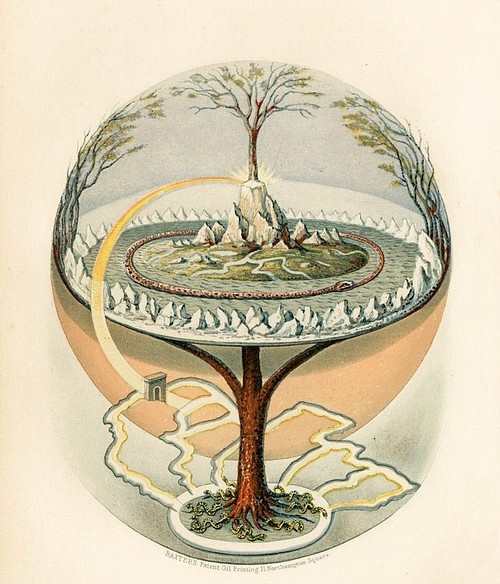
Nithhogg is the dragon who gnaws at the roots of the World Tree but was also envisioned as a creature in the dark realm of Nastrond who chewed on the souls of murderers, oath breakers, and rapists, draining them of blood, and turning them into the army of the dead who will join the forces of chaos in the final battle with the gods. The “aged giantess” who raised Fenrir’s sons is his mother Angrboda who lived in the Iron Wood. Verses 43, 47, and others describe Fenrir howling at the gates of Hel and her offering him assistance in the form of an army of the dead. Scholar Robert Carlson describes the rest of the beginning of Ragnarök:
Human bonds of kinship as well as traditional beliefs will shrivel and disappear. A listless anarchy will evolve. Then there will be a period of time known as Fimbulvetr, characterized by three winters of increasing severity with no summers in between. Three roosters will crow: the crimson rooster Fjalar will crow to the Giants; the golden cock Gullinkambi will crow to the gods; and a third cock will raise the dead. The sun will be devoured by the wolf Skoll, and his brother, Hati, will eat the moon, leaving the world in darkness. Earthquakes will set Fenrir the Great Wolf free, and he will open his mouth so wide that his upper jaw captures heaven and his lower jaw the Earth, and he will rampage through all the nine worlds, destroying all that lives. Great mountains will fall in on their foundations. The seas will overrun the land as the serpent Jormungandr comes ashore. (20)
The ship Naglfar, built of the fingernails of the dead, comes over the waves, steered by the giant Hrym while a second ship, supplied by Hel and steered by Loki, brings Surtr and the Fire Giants to the battlefield where Odin, the gods, and the great heroes of Valhalla are arrayed for battle. The rainbow bridge Bifrost cracks and falls as Yggdrasil shakes and the forces of order and chaos clash in the final battle. Odin is killed by Fenrir who is then slain by Odin’s son Vidarr. Almost all of the gods fall in the battle, including Thor and Loki, but the survivors are victorious over the forces of chaos. The Nine Realms fall in flames but, out of their ashes, a new world arises, and order is ultimately triumphant.
Conclusion
After the battle, there is again nothing but the World Tree and the misty void of Ginnungagap and another cycle of life begins. There are no descriptions of what the new world will look like, but it was understood as a reality since, according to Norse belief, all of life was cyclical. Nothing was ever lost, even though it seemed to be, because it would always return in another form. It is even suggested that Fenrir’s memory survives in this new world since Vidarr lives through Ragnarök and it is assumed he and the others will tell the tale of the last great battle and the slaying of the giant wolf. Scholar John Lindow comments:
Like his father Loki and his brother, the Midgard serpent, Fenrir is a creature who spends time among the gods, is bound or cast out by them, and returns at the end of the current mythic order to destroy them, only to be destroyed himself as a younger generation of gods, one of them his slayer, survives into the new world order. (114)
Ragnarök, as noted, was decreed by the Norns but was brought about, in part at least, by the actions of the gods themselves in dealing with Loki’s children. One of the most intriguing aspects of the stories is the question of freewill vs. predestination. Did Odin treat Loki’s children as poorly as he did of his own will or because it was written that he should by the Norns and he had no other choice?
In Norse belief, one’s fate was already decided at one’s birth and the best one could do was to live well and hope for a good reputation that would survive one’s death. What one did between birth and death, however, was entirely up to the individual. Considering this understanding, it is likely that Odin had a choice in how he treated Fenrir and chose poorly, thereby aligning the great wolf with the forces of chaos when he could have stood as an ally and defender of the established order of the gods.
